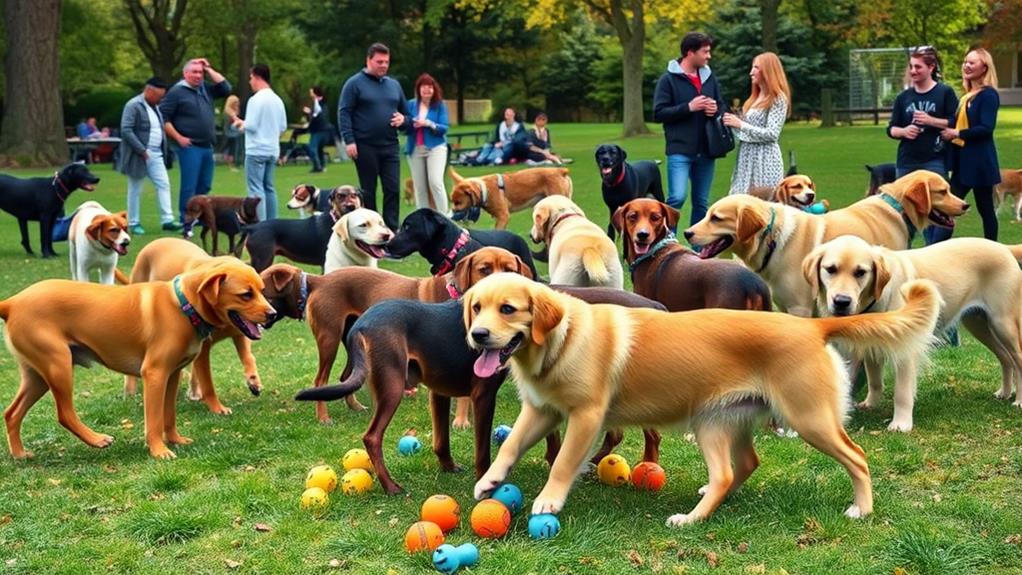Helping your new pup thrive in existing social circles starts with understanding their personality and energy levels. Establish a routine for feeding and play, and [ALTERNATIVE WORDS] guarantee they get mental stimulation. Gradual introductions are key; begin with controlled meetings and pay attention to body language. Use positive reinforcement to reward good behavior and set up playdates with compatible pups. Always monitor interactions, looking out for signs of stress, and provide breaks when needed. By celebrating small victories, you'll boost your pup's confidence. Curious how to further enhance your pup's social experiences? There are plenty of strategies to explore!
Understanding Your Pup's Needs
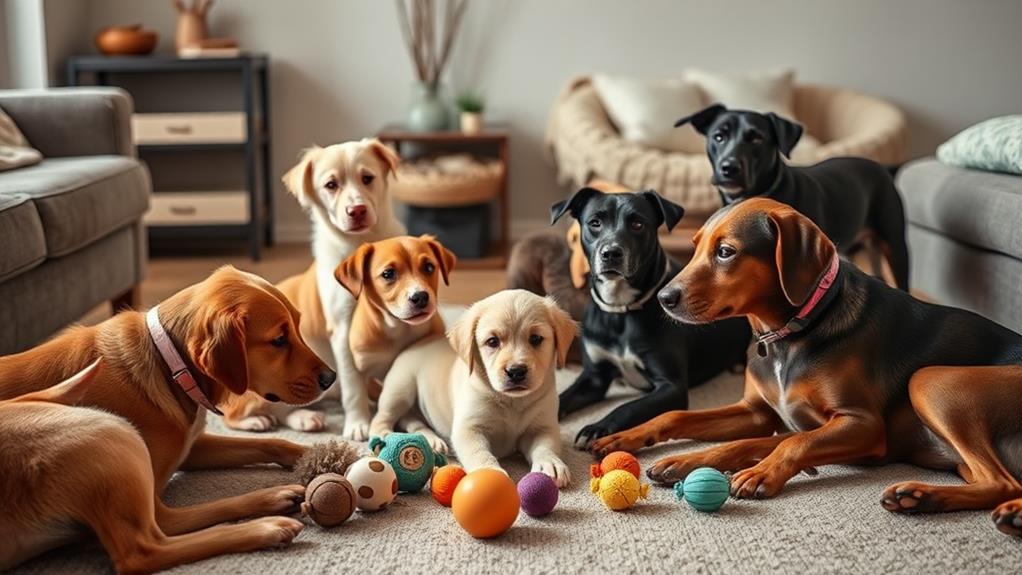
To help your new pup thrive, it's essential to understand their unique needs and personality traits. Every dog has a distinct character shaped by their breed, age, and experiences. Observing your pup will give you insights into what they require to feel secure and happy. Is your dog more independent or social? Does it prefer cuddles or space?
You'll want to establish a routine that includes feeding, exercise, and playtime tailored to their energy level. Active breeds often need more physical activity, while calmer dogs may enjoy shorter walks. Make sure their diet is appropriate for their age and size, as proper nutrition is key to their overall well-being.
Mental stimulation is equally important. Engage your pup with toys, puzzles, or training sessions that challenge their minds. This not only keeps them entertained but also helps build a strong bond between you. Additionally, be attentive to their emotional needs. Your new pup may need time to adjust to their new environment, so patience and reassurance are critical during this period. By recognizing and addressing these needs, you'll set the foundation for a happy, healthy relationship with your furry companion.
Assessing Current Social Circles
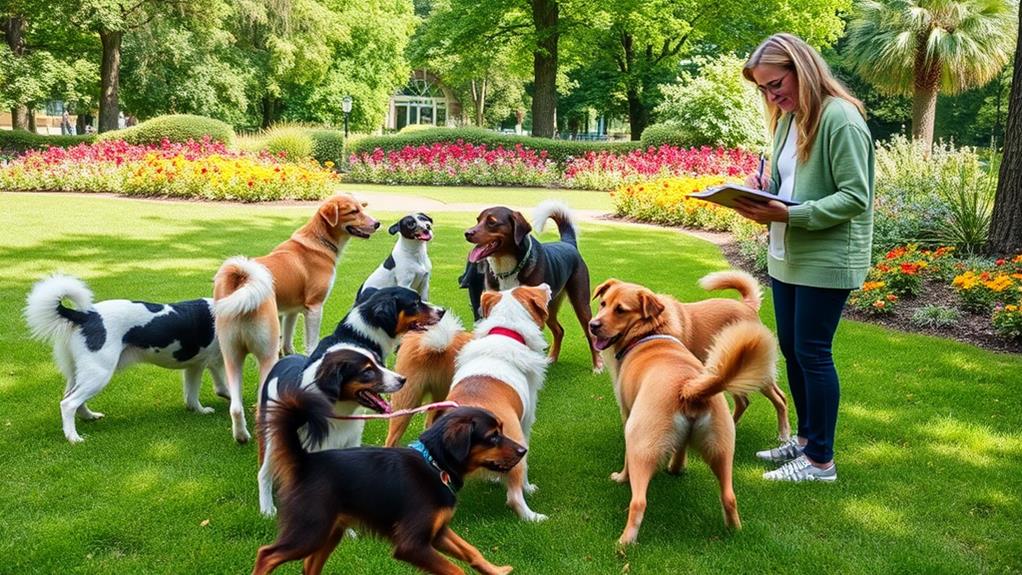
Understanding your new pup's needs sets the stage for evaluating their current social circles. You'll want to identify which interactions are positive and which might be overwhelming for your furry friend. Consider the personalities of the dogs and people in their environment. This assessment will help you create a supportive atmosphere for your pup.
To help visualize the dynamics, use the table below:
| Interaction Type | Positive/Negative |
|---|---|
| Playtime with familiar dogs | Positive |
| Encounters with larger dogs | Negative |
| Visits from new people | Neutral |
Observe how your pup reacts during playdates and outings. Are they excited or anxious? Take notes on these interactions to better understand their preferences and discomforts. Pay attention to body language, as it can reveal a lot about how your pup feels in different social situations.
Gradual Introductions to New Friends
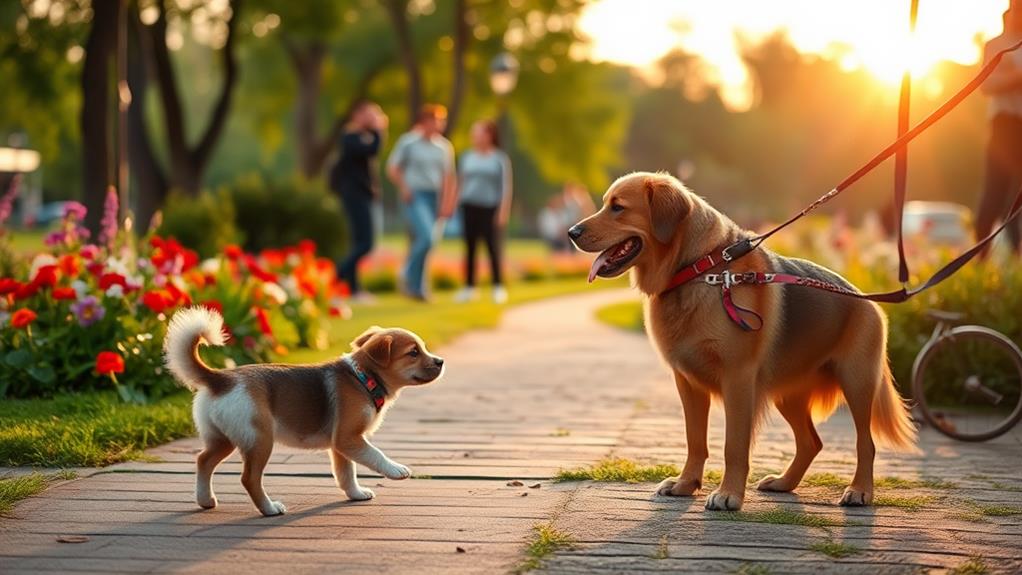
Introducing your new pup to potential friends should be a gradual and thoughtful process. Rushing introductions can overwhelm your dog and lead to negative associations with new experiences. Instead, take your time to ascertain everyone feels comfortable.
Start Slow: Begin with short, controlled meetings in a calm environment. This helps your pup feel secure and reduces anxiety.
Observe Body Language: Pay attention to how both your pup and the new friends react. Look for signs of stress or discomfort to gauge if you need to slow things down.
Use Familiar Faces: Introduce your pup to friends who are already dog-savvy. They can help model positive interactions, making your dog feel more at ease.
Gradually Increase Interaction: As your pup becomes more comfortable, slowly extend the duration and complexity of the interactions. This helps build confidence.
Positive Reinforcement Techniques
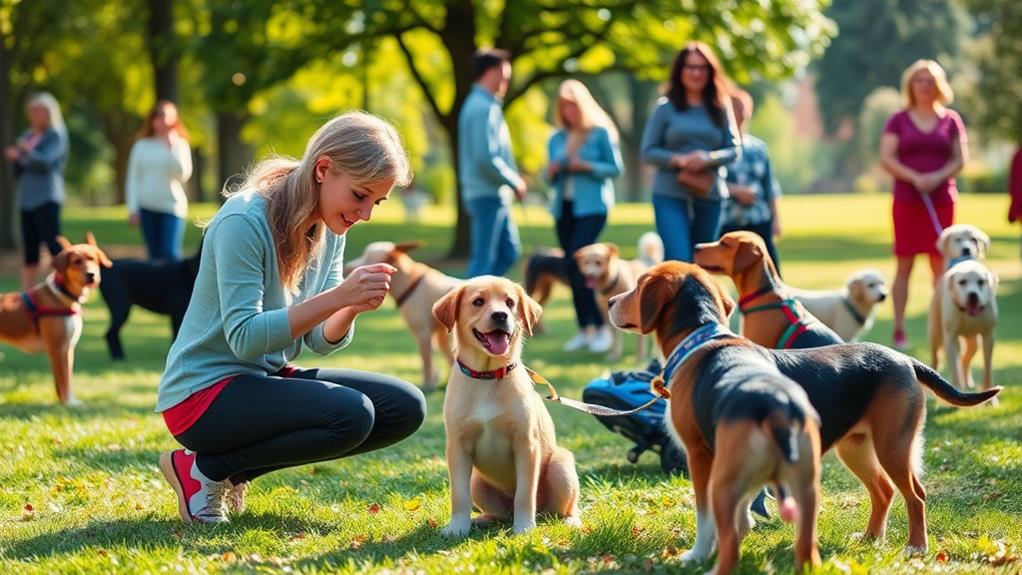
Using positive reinforcement techniques can greatly enhance your pup's socialization experience. When your dog interacts with new friends, reward them for good behavior with treats, praise, or playtime. This encourages them to associate positive experiences with social interactions. For instance, if your pup greets another dog calmly, immediately give them a treat. This reinforces the behavior you want to see again.
Timing is paramount. Make sure to reward your pup right after the desired behavior occurs. This way, they'll connect the dots between their actions and the reward. If your pup gets too excited or barks excessively, withhold the reward and redirect their attention. You can use a firm "no" followed by a positive command, like "sit," to help them focus.
Additionally, consistency is key. Ensure everyone in your social circle understands and uses the same reinforcement techniques. This will help your pup learn faster and feel more secure in their social environment. Remember, patience is essential. It might take time for your pup to adjust, but with positive reinforcement, they'll thrive in their new social settings. Keep the atmosphere fun and encouraging, and watch your pup flourish!
Setting Up Playdates
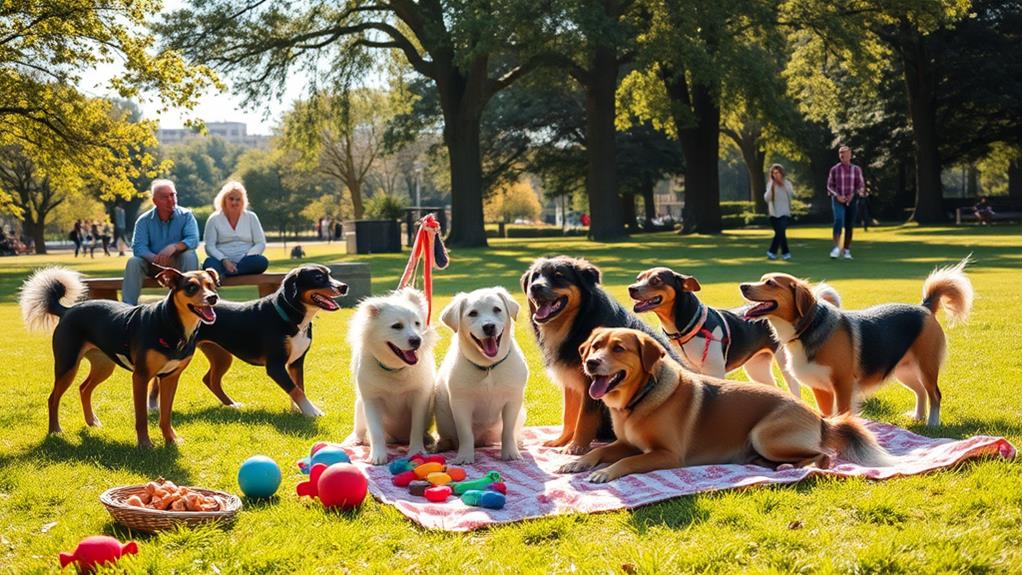
Setting up playdates for your pup can be a fun and rewarding experience, especially when you consider how much they can benefit from social interactions. To ascertain that these playdates are successful, keep a few key factors in mind.
First, choose the right playmates. Look for dogs that are friendly and have similar energy levels to your pup. This helps create a positive environment where both dogs can enjoy themselves.
Next, select a suitable location. Whether it's your backyard or a local dog park, make sure the space is safe and secure.
- Schedule Regular Playdates: Consistency helps your pup become more comfortable with others.
- Monitor Playtime: Keep an eye on the interactions to confirm they remain friendly and fun.
- Provide Breaks: Allow both pups to rest if they seem overwhelmed.
- Bring Toys: Having familiar toys can make your pup feel more at ease.
Observing Body Language

After playdates are scheduled and the pups are interacting, it's important to pay close attention to their body language. Dogs communicate a lot through their posture, tail position, and facial expressions. When your new pup feels relaxed, you'll notice a wagging tail held at a neutral height, loose body posture, and soft eyes. These signs indicate they're comfortable and enjoying the playdate.
On the flip side, if you see stiff body language, a lowered tail, or pinned ears, it could signal anxiety or discomfort. Watch for signs of aggression, like growling or showing teeth. In these cases, it's essential to intervene and redirect the pups' energy.
If your pup approaches another dog with a play bow—front legs stretched forward while the back end remains upright—this is an invitation to play. Conversely, if a dog turns away or raises a paw, they might be feeling overwhelmed.
Keeping an eye on these cues helps you gauge the pups' comfort levels. Observing their interactions closely guarantees a safe and enjoyable experience for everyone involved, reinforcing positive social behaviors in your new pup.
Encouraging Interactive Activities
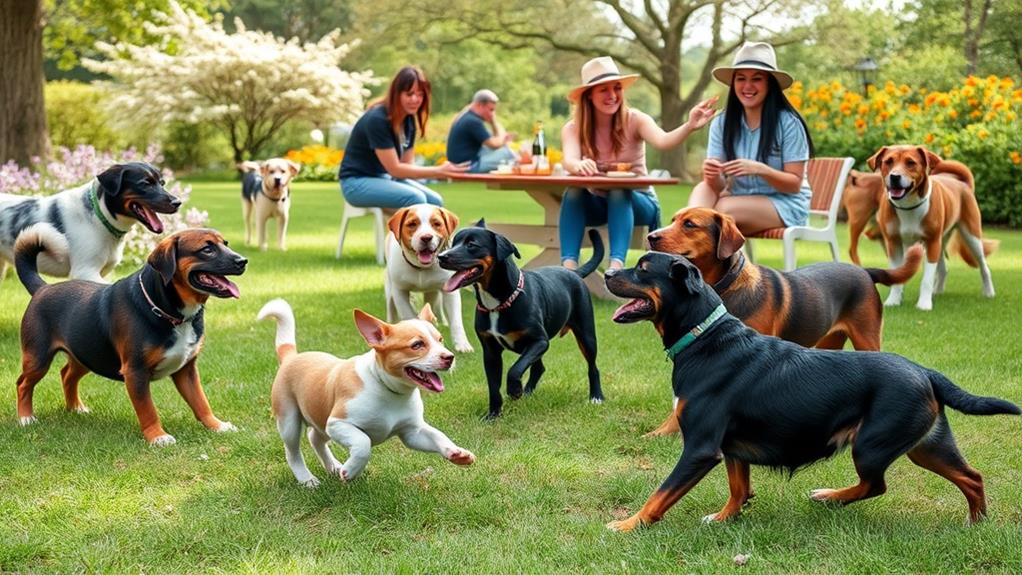
Fostering interactive activities during playdates can markedly enhance your new pup's social skills and confidence. By engaging them in fun, structured games, you create opportunities for socialization and bonding with other dogs.
- Fetch: This classic game encourages friendly competition while teaching your pup to share and wait their turn.
- Obstacle Courses: Set up simple hurdles or tunnels to navigate, promoting agility and teamwork as your pup learns to follow cues from you and their peers.
- Tug-of-War: This game not only builds strength but also helps your pup understand boundaries and the importance of gentle play.
- Group Training Sessions: Incorporate commands during playtime, allowing your pup to learn new skills while interacting positively with others.
These activities not only keep playdates exciting but also cultivate a supportive environment where your pup can thrive socially. Guarantee you supervise their interactions, providing guidance and encouragement as they explore these engaging experiences. By promoting interactive play, you're laying the foundation for a well-adjusted, confident dog who can navigate their social circles with ease.
Managing Conflicts and Stress

While playdates are a great opportunity for socialization, conflicts can arise, making it essential to manage stress effectively. When tensions surface, your first step is to stay calm. Dogs can sense your emotions, so if you're anxious, they might become anxious too. Instead of jumping in, observe the situation to identify triggers and patterns.
If a conflict escalates, intervene gently. Separate the dogs using positive distractions like toys or treats. This helps redirect their energy and reduces hostility. After the situation cools down, give both pups a bit of space to decompress. Remember, creating a safe environment is key to successful interactions.
You should also watch for signs of stress in your dog, such as excessive barking, growling, or hiding. If you notice these behaviors, it's paramount to remove your pup from the situation before it escalates. Instead of forcing interactions, encourage breaks and reward calm behavior.
Celebrating Small Wins

Celebrating small wins can make a significant difference in your pup's socialization journey. Each step forward, no matter how minor, deserves recognition. These moments not only boost your pup's confidence but also strengthen your bond, making the experience enjoyable for both of you.
First Encounter: A successful introduction to another dog or person.
Calm Behavior: Remaining calm during a busy outing or at the dog park.
Positive Responses: Responding well to commands amidst distractions.
Exploration: Showing curiosity about new environments or smells.
Frequently Asked Questions
What Breeds Are Best for Socializing With Existing Dogs?
To socialize with existing dogs, consider breeds known for their friendly nature, like Labrador Retrievers, Golden Retrievers, and Beagles. They're typically more adaptable and enjoy interacting with other dogs, making introductions smoother for everyone.
How Do I Introduce My Pup to Other Pets?
Did you know that 60% of dog owners report successful introductions lead to lasting friendships? To introduce your pup, keep it calm, let them sniff each other, and monitor their body language for comfort and stress.
Can My Pup Have Too Many Playdates?
Yes, your pup can have too many playdates. Over-scheduling may lead to exhaustion or anxiety. Balance is key; guarantee your pup has downtime to recharge between playdates and enjoy a healthy social life.
What Should I Do if My Pup Is Shy?
Did you know that around 30% of puppies show signs of shyness? To help your pup, create a safe space, introduce them gradually to new experiences, and offer plenty of encouragement and positive reinforcement.
Are There Specific Age Groups for Ideal Socialization?
Yes, there are ideal age groups for socialization. Puppies between 3 to 14 weeks are most receptive. Socializing during this window helps them develop confidence and adapt better to different environments and other dogs later on.
Conclusion
By understanding your pup's needs and gradually introducing them to your existing social circles, you're setting the stage for a tail-wagging good time! Remember, patience is key—every small win is like a victory parade for your furry friend. Keep an eye on their body language, encourage fun activities, and manage any conflicts with care. With your love and support, your pup will thrive in their new social life, becoming the life of the dog park in no time!

